
|
1986 - 1988 |
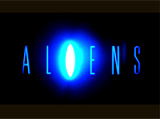
|
It was notable for the way it combined numerous in-camera special-effects elements and techniques into the same shot. Live action, creature models (full-sized and scale miniatures of the giant alien Queen), matte paintings, composites, front and rear projection, and various other elements were brought together through a beam-splitter. The Queen was in fact, a 14 foot model, operated by 16 puppeteers (two were inside the puppet itself) to control its arm, head, tail and jaw movements. The Queen possessed two pairs of arms, one large and one small, and had a body constructed out of aluminum and fiberglass with steel armatures. During the largest-scale action scene in the film's conclusion, the egg-laying, hive Alien Queen ripped herself away from her egg-sac ovipositor and chased after Ellen Ripley (Sigourney Weaver) and 11 year-old Newt (Carrie Henn) - angered that her egg chamber had been incinerated. Just before a nuclear explosion detonated and destroyed the entire processing facility, the two were picked up by android science officer Bishop (Lance Henriksen) (an "artificial person") in a drop-ship, and returned to the massive mothership, USS Sulaco.
The Queen had secretly stowed away onboard inside the landing gear of the drop-ship. It attacked and impaled Bishop with its huge stinger tail. Bishop was lifted up by the tail to the ceiling where the Queen was hiding, and then ripped in half at the waist. The severed upper half of Bishop dropped to the floor, and saved Newt from being ejected out of the decompressing cargo hold. Ripley donned a P-5000 Power Loader to fight off the Queen one-on-one.
|
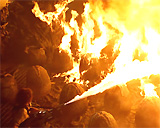 Ripley's Flamethrower Destroying Egg Chamber  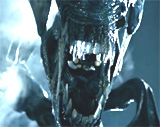 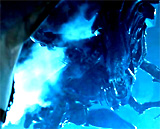 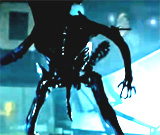 The Alien Queen Threatening |
|||||||||||||||||
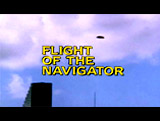
|
Flight of the Navigator (1986) Director Randal Kleiser's and Disney's live-action sci-fi-comedy (called "the ultimate fantasy") followed on the heels of many other kids' adventure films with aliens and space themes (i.e., E.T.: The Extra-Terrestrial (1982)). Reportedly, there were 61 different optical effects shots in the film (including motion-controlled miniatures), although only 18 used CGI or computer animation. It was the first feature film to use 'reflection mapping' to provide digital gloss -- for the shiny, silvery chrome surface or reflective metallic skin of the flying CGI alien spaceship as it zoomed over the landscape and reflected airports, fields, buildings, and oceans. The process involved mapping a photographic image onto the CG surface to create the illusion that the object was reflecting the environment.
This fantasy set on July 4th in the year 1986 (in Fort Lauderdale, FL) began with the discovery of the kidnapping-abduction of 12 year-old David Freeman (Joey Cramer) by aliens eight years earlier on July 3rd in 1978, but the boy had not aged. Before returning David to his home, ominous NASA scientists wanted to scan and test David's brain at a top-secret research lab - and discovered his mind was filled with star charts, alien data and other technical information. Meanwhile, a shell-shaped, silver-chrome colored extraterrestrial spaceship had crashed into some power lines, and NASA planned to study it too - although the craft was impenetrable. To try to understand what had happened to him and also to find his way home (to the original year of 1978), David escaped from the lab by hiding in a NASA service robot that delivered mail, known as R.A.L.F. (aka Robotic Assistant Labor Facilitator). He snuck into the hangar where the spaceship (aka Trimaxion Drone Ship) was being stored. There, he entered the spaceship and befriended an alien life form - an AI computer robot pilot named MAX (voice of Paul Reubens). The research spaceship (rendered in CGI), that could fly faster than light, also had an assortment of extraterrestrial creature samples on board (for example, a bat-like alien named Puckmaren, the last-surviving member of his species from his destroyed planet of Binpuka Minor). The boy came to understand that he was the "Navigator" of the film's title - and was destined to escape from the NASA base and to assist MAX - with the information in his brain - in order to return the spacecraft back to its home planet of Phaelon. At first David piloted the spaceship around Earth - on a joyride. It was revealed that during the 8 year gap in time, David had been flown to the distant planet of Phaelon (560 light years from Earth) to be analyzed as a human specimen (for only 4.4 hours), and then he was returned to Earth, although 8 years had passed in the meantime due to the concept of time dilation. On the spacecraft's attempted flight back home, MAX had accidentally crashed the ship into the power lines, erasing all the star charts and data necessary to get him back to Phaelon. The film concluded as Max agreed to travel back in time to 1978 with David, to return him unharmed to his home. |
 David Freeman (Joey Cramer) 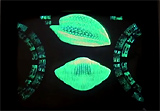 David's Odd-shaped Brain Scans 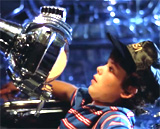 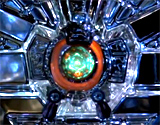 Computer Robot Pilot MAX 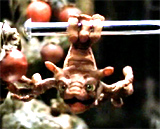 Bat-like Alien Puckmaren 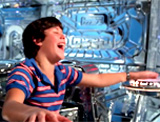 David Navigating the Spacecraft Around Earth |
|||||||||||||||||
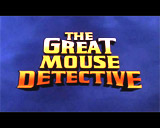
|
The Great Mouse Detective (1986) During the complex chase scene at the end of the film within London's famed bell tower Big Ben, Basil pursued the evil Ratigan through a complex environment of interlocking gears and cogs. The images of the turning, interlocking cogs/gears of the clock (in the background) were modeled and animated with 3-D computer animation techniques, while the characters were drawn by hand. The wireframes were output to animation cells (or drawings) on paper with a pen plotter, and then hand-painted. They were then integrated with the foreground hand-drawn characters during the production process. |
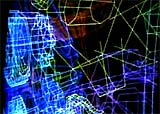 Wire-Framing 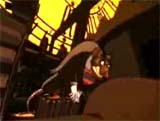 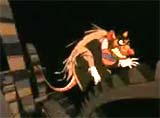 The Big Ben Tower Chase |
|||||||||||||||||
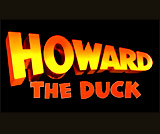
|
Howard the Duck (1986) This notoriously-bad, executive-produced George Lucas film - a Marvel Comics adaptation about an anthropomorphic duck, cost $37 million and was a major box office failure that barely recouped its expenses. Noteworthy however, was the fact that it was the first film to use digital wire removal or deletion, a technique pioneered by Industrial Light and Magic (ILM). The scene using the milestone special effect occurred in an early scene when Howard was sitting in his arm-chair in his apartment. Suddenly, the chair began to violently vibrate (like in an 'earthquake'), and Howard (still in the chair) was rocketed away backwards. He and his arm chair flew horizontally through the door of his apartment and then through multiple plaster walls of his neighbors, including bedrooms and bathrooms. (The movement was caused by steel wires that pulled the puppet and prop horizontally through multiple walls and sets.) Howard entered orbit out of Duckworld and was flown to Cleveland, Ohio on planet Earth.
A computer program or graphics tool known as LayerPaint was used to do the paint work for the wire removal at ILM. It was described as an error-prone and tedious process, since the original version of LayerPaint was used to inspect and load each individual frame of a sequence (one at a time). Then, after the erasure of the wire, each completed frame was saved out manually.
In other instances, wires were used in live-action filming to simulate either flying actors or miniatures. Besides props or puppets, Howard was also portrayed by stunt men in a duck suit. |
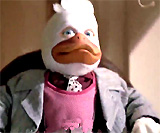
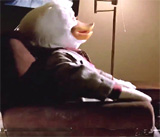 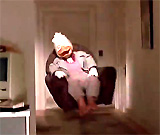 Howard the Duck in Arm-Chair - Pulled Backwards |
|||||||||||||||||

|
Labyrinth (1986) The memorable CGI opening credits/title sequence included a digitally-created flying owl (the first photo-realistic CGI animal in a feature film) and a crystal glass ball. The owl was given tone mattes on each individual feather, to heighten the illusion of realism. The film also featured M.C. Escher-style production design, including the final "stairway sequence" - in the upside-down room in the Goblin City (modeled after Escher's "Relativity" drawing of stairs on different planes). In the ever changing maze environment of the Labyrinth, Jareth the Goblin King's (David Bowie) crystal ball bounced across the multiple perspectives of the room and up a flight of stairs - directly into the hand of Sarah's (Jennifer Connelly) baby stepbrother Toby (Toby Froud) -- it was a reversed shot. |
 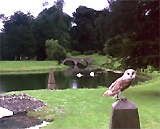 CGI Flying Owl 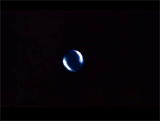 CGI Crystal Glass Ball 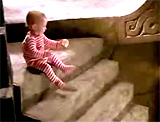 Flight of Stairs Sequence |
|||||||||||||||||
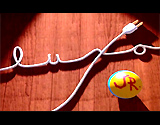
|
Luxo Jr. (1986) It was also the first computer (CG) animation short to be nominated for an Academy Award. The desk lamp later became the corporate or trademark symbol for Pixar. It was notable as the first fully computer-generated, computer-animated (or CGI) film, and the first to use shadows in CGI (made possible by Renderman software). |
 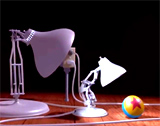
A Pair of Desk Lamps |
|||||||||||||||||

|
Star Trek IV: The Voyage Home (1986) This fourth installment of the live-action feature film Star Trek franchise was the first groundbreaking, cinematic use of 3D scanning by Cyberware scanning software.
This type of 3D scanning was first used on the heads of Star Trek actors when ILM digitized them for a short time-warp travel scene. The CG heads of William Shatner and Leonard Nimoy were too complex for conventional modeling techniques at the time - instead they were scanned by the first Cyberware 3D Scanner, to produce disembodied cyber-sculptures of their heads. In the film, the Enterprise officers were forced to sling-shot themselves around the Sun in order to time-travel back to the late 20th century from the 23rd century - their objective was to locate humpback whales and bring them forward in time to save the doomed planet Earth from a destructive, power-sucking probe. |
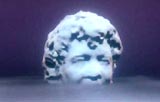  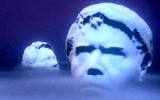 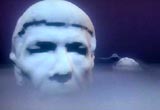 3D Scanned Heads |
|||||||||||||||||
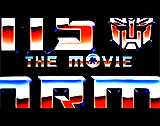
|
The Transformers: The Movie (1986) Based on the popular weekday afternoon cartoon series during the 80s, this full-length animated adventure about giant, alien robot warriors was another early melding of traditional and computer animation, using TRON-style backlighting. The main plot was about warriors known as The Transformers, from a planet called Cybertron. There was conflict between the two factions:
The Decepticons were allied with the colossal, planet-devouring Unicron (voiced by Orson Welles in his final role). In its downbeat, apocalyptic plot (with a cliffhanger ending) all of the series marquee regulars were killed off in the Battle of Autobot City. |
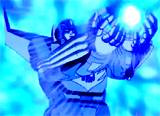 
|
|||||||||||||||||
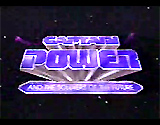
|
Captain Power and the Soldiers of the Future (1987-1988, Canada/US) - TV This was the first science fiction-action TV series (of 22 episodes in its first and only year airing from September 1987- March 1988) that merged live action with CGI animation. It was the first TV series to include modeled 3D characters entirely computer-created. Although funded by Mattel and advertised as a children's series, it was incredibly violent. It was expensive (a million dollars per episode), with its innovative special effects. The post-apocalyptic plot was set in the 22nd Century (in the year 2147 on Earth), following the Metal Wars in which military machines (advanced robotic soldiers) were victorious. The political system of the Empire was controlled by:
Opposed to the Bio-Dreads were Resistance Forces, led by:
Soaron (voice of Deryck Hazel) and later Blastarr (voice of John S. Davies) were two primitive CGI robots that appeared in the series. Soaron was armed with a digitizer ray that could turn humans into computer data, which was then fed into a supercomputer called Overmind (voice of Ted Dillon). |
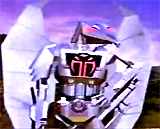 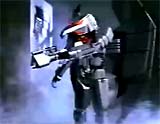 Soaron - a Bio-Dread (or Advanced Bio-Mech) 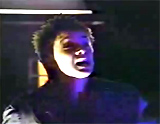 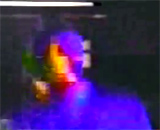 The "Digitizing" Death of a Human Survivor: Athena (Ann-Marie MacDonald) |
|||||||||||||||||
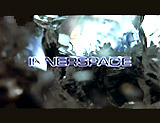
|
InnerSpace (1987)
The winner was director Joe Dante's goofy sci-fi comedy Innerspace (executive-produced by Steven Spielberg). It was a throwback to films such as Fantastic Voyage (1966) and The Incredible Shrinking Man (1957), with its own take on a miniaturizing experiment performed on humans injected into the blood stream. It was probably the inspiration for Disney's sci-fi family film Honey, I Shrunk the Kids (1989) just a few years later. It was visually cartoonish and dazzling, with its zany tale of a secret medical-surgical experiment performed on often-drunk, hot-shot US Navy test pilot Lt. Tuck Pendleton (Dennis Quaid), who was becoming involved again with his blonde ex-girlfriend Lydia Maxwell (Meg Ryan), a newspaper reporter. He volunteered for a secret miniaturization experiment, wherein he was placed in a submersible pod-craft or capsule within a Silicon Valley lab known as Vectorscope, then shrunk to molecular size, and transferred to a syringe to be injected into the body of a live rabbit.
However, the experiment went awry and things became manic and complicated when a group of orange-suited henchmen broke into the lab, and stole one of the two crucially-important computer micro-chips. Their objective was to acquire the technology involved and profit from its sale. The sabotage of the experiment was led by:
When the two rival scientists attempted to steal the miniaturized Lt. Tuck Pendleton and his tiny vessel in the syringe, the experiment's supervisor Dr. Ozzie Wexler (John Hora) ran off with it to the Santa Clara Fashion Square shopping mall. He was pursued there and shot by Canker's henchmen Mr. Igoe, but at the last moment before collapsing was able to inject the syringe contents into the butt of hypochondriacal Safeway grocery store clerk Jack Putter (Martin Short). At first, Tuck was not aware that he had been induced into the bloodstream of a second individual rather than the rabbit. After navigating the pod to the optic nerve of his "host" Jack, he was able to observe and realized what had happened - (he exclaimed to himself: ("I'm in a man!... I'm in a strange man surrounded by strangers in a strange world").
Through Jack's inner ear, Tuck was able to talk to Jack - who at first thought he was possessed and 'hearing things' - he worried: "Somebody help me. I'm possessed!" A doctor at Westpark Medical diagnosed him as suffering from hysteria. Eventually, Tuck was able to instruct Jack about how they had to work together. There were two major issues: (1) there was only enough oxygen in Tuck's pod air supply until 9:00 am the next morning, and (2) enlarging the pod required the two computer chips, but one had been stolen by Dr. Canker and Scrimshaw. (The other chip was still in the pod.) Things became very idiotic and crazed after Jack was instructed to meet up with Tuck's on-and-off again girlfriend Lydia in San Francisco, with the goal to steal back the stolen computer chip from Scrimshaw. Later on, they happened to kiss - their shared saliva transferred Tuck (in the pod) into Lydia's body! Meanwhile, in the rivals' lab, Scrimshaw shrank Mr. Igoe in a pod, and also injected him into Jack to accomplish a number of tasks: take control of the pod and seize the computer chip attached to the pod, eliminate Tuck, and then enlarge the pod still inside Jack's body (inevitably killing Jack, as Dr. Canker speculated: "Have you any idea what kind of mess that would make?"). Scrimshaw and Canker didn't know that Tuck was now inside Lydia, where Tuck realized that he had impregnated her and fathered a child when he saw the fetus of his own son (or daughter) - he exclaimed to himself: "Lydia, I'm a Dad!" In the rivals' lab, Jack and Lydia (holding a gun) ordered the miniaturization of the two villains, Dr. Canker and Scrimshaw (and their assistants), but they were only inadequately shrunk to 50% or half-size. Jack and Lydia also reacquired the stolen microchip, and they kissed again to transfer Tuck from Lydia back into Jack's body. And then in a unique F/X sequence exhibiting the use of forced-perspective, they raced in a car through the streets of San Francisco. The normal sized heroes, Lydia and Jack, were in the front seat, fighting with the half-sized miniaturized villains Dr. Canker and Scrimshaw who were in the back-seat - in real-time. With Tuck's pod back in Jack's body, Mr. Igoe (who was also there) located Tuck in Jack's esophagus and attacked him. Tuck disabled Mr. Igoe's craft, forcing Igoe to eject himself from the pod. Tuck then threatened him: "Okay, pal. Here's how I spell relief!", and dropped him in his protective suit into Jack's stomach acids to kill him. The unshielded villain was disintegrated by the corrosive digestive enzymes into nothing more than a skeleton. A nauseated Tuck informed Jack after seeing Igoe's skeletal remains: "Jack. It worked. You just digested the bad guy." Jack burped in response.
With oxygen and time running out, Lydia and Jack were driven back to Vectorscope so they could enlarge Tuck’s pod. With no time left to use the proper procedure, Tuck instructed Jack to make himself sneeze, in order to eject the pod from his lungs. After being sneeze-ejected from Jack, Tuck and the pod were enlarged (using the second retrieved chip) and Tuck was reunited with Lydia - he also met Jack in person. Both Dr. Canker and Scrimshaw remained half-sized, and caused havoc in the final sequence after Tuck's and Lydia's wedding - by hiding in a piece of luggage in the trunk. As they drove away for their honeymoon, Jack saw that their limousine driver was wearing boots - he was The Cowboy in disguise. Jack drove after their car to try and alert them (announcing "Jack Putter to the rescue!"), as the end credits played to the tune of "Twistin' the Night Away" by Sam Cooke. |
|
|||||||||||||||||
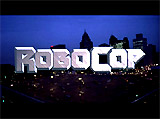
|
Robocop (1987) Director Paul Verhoeven's action film (his first major Hollywood production) had the tagline: "PART MAN, PART MACHINE, ALL COP" - referring to the title character, a superhuman cyborg law enforcer known as "RoboCop." Two different traditional techniques were used in the scenes involving an ED-209 (Enforcement Droid) prototype being demonstrated at the Omni Consumer Products (OCP) headquarters:
OCP Senior President Dick Jones (Ronny Cox) announced plans for his company to transform the dystopic Old Detroit (suffering from the "cancer" of crime) into a utopian Delta City; he gave a stirring preview of future law-enforcement - a round-the-clock robotic cop: "We need a 24-hour-a-day police officer. A cop who doesn't need to eat or sleep. A cop with superior firepower and the reflexes to use it." In the product demonstration sequence, Jones spoke about a new robotic ED (Enforcement Droid) for "urban pacification" - a Series 209 prototype; it was heralded as "a self-sufficient, law-enforcement robot" and "the hot military product for the next decade." He introduced a giant, awkward, top-heavy robot to show a simulated arrest and disarming procedure of an "arrest subject" - an innocent opponent selected from the audience named Kinney (Kevin/Ken Page). When the demo began, ED-209 gave a stern warning when Kinney's Desert Eagle pistol was threateningly pointed at it: "Please put down your weapon. You have 20 seconds to comply," but the incompetent, poorly-performing ED-209 malfunctioned, stepped forward, growled in a deep voice, and warned: "You now have 15 seconds to comply," even when the gun was surrendered and thrown down on the floor. After a countdown, it mercilessly killed Kinney with a violent volley of shots, claiming it was now authorized to use "physical force" according to Penal Code 1.13, Section 9; Kinney died after falling backwards onto a model of Delta City.
The embarrassing, malfunctioning droid during the product display resulted in a massacre one of the executive board members. Executive Bob Morton (Miguel Ferrer) shouted for assistance to a hapless volunteer: "Somebody want to call a god-damn paramedic?" The OCP's head of the board, the Old Man (Dan O'Herlihy) was upset by the failed robot, and spoke harshly to Senior President Dick Jones: "Dick, I'm very disappointed", and Jones responded - with a classic line: "I'm sure it's only a glitch, a temporary setback."
|
 OCP Senior President Dick Jones 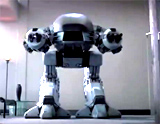 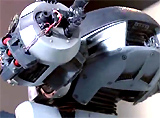 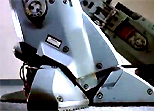 The ED-209 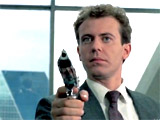 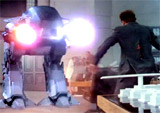 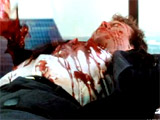 Kinney's Death by Malfunctioning ED-209 |
|||||||||||||||||

|
Akira (1988, Jp.) Akira was an excellent example of a feature-length, science-fiction Japanese anime - "Japanimation" - from director Katsuhiro Otomo, and based on his science-fiction comic book (manga) of the same name. The cyberpunk thriller was about a military project set in a dystopian, post-war, neo-Tokyo in the year 2019, 31 years after the metropolitan city was destroyed in a gigantic explosion that initiated WWIII. It was unlike the G-rated Disney animations of the time marketed for children, with mature themes, extreme violence, kinetic action, depictions of corruption, and more. The main characters were street punk teens (in rival biker gangs) who became involved in a top-secret government program involving psychokinetic powers and experimental subjects. At its time, it was budgeted at $8.2 million, and eventually ended up costing $10 million, making it the most expensive film ever produced in Japan. It employed 68 key animators in its creation. Akira has often been considered the greatest animated film of all time, with advanced technical features, such as highly-detailed hand-painted scenes (with textures, shadows, and 327 distinct and different colors used), and seamless cel animation with over 160,000 animation cels. Akira also used CGI for some of the film's important details, including Doctor Onishi's pattern indicator. |
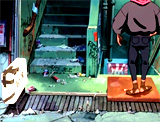 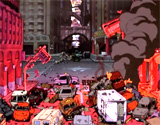 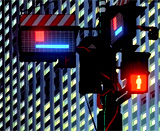 Detailed Animations 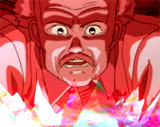 Doctor Onishi's Pattern Indicator (CGI) |
|||||||||||||||||
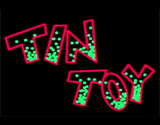
|
Tin Toy (1988) Pixar's and director John Lasseter's 5-minute short film was the first fully computer animated (CGI) film to win an Academy Award Oscar - for Animated Short Film. It was a reaffirming test of the power of PhotoRealistic RenderMan software. Billy, the drooling baby character in the short film, marked the first time that a CG character had realistic human qualities.
|
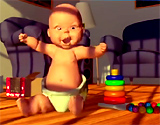 Billy 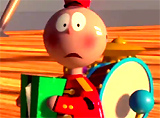 Tinny |
|||||||||||||||||
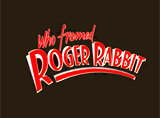
|
Who Framed Roger Rabbit (1988)
It was a coordinated effort (produced by Disney, live-action directed by Robert Zemeckis, and animated by Richard Williams) - a remarkable blend of animated imagery (hand drawn and painted), and hand matched to the live action human characters, and filmed as a tribute to the entire pantheon of cartoon characters from Disney, Warner Bros., and MGM, and other studios in the 1940s. Roger Rabbit's character and appearance was a composite or hybrid of many elements: specifically drawn as a Looney Tunes character with overalls (Disney's Goofy), gloves (Mickey Mouse), and a bow tie (Porky Pig). Likewise, Jessica Rabbit was inspired by the looks and mannerisms of Lauren Bacall, Rita Hayworth, and Veronica Lake, as well as the heroine in Tex Avery's cartoon short Red Hot Riding Hood (1943). The animation included sophisticated shading, lighting and shadows to dramatically make the hand-drawn animated characters appear very 3-D and lifelike as they interacted with real-world objects and people. |
 Betty Boop and PI Eddie Valiant (Bob Hoskins) 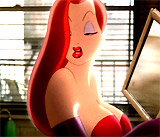 Jessica Rabbit  Roger Rabbit with Eddie 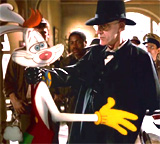 Roger With Judge Doom |
|||||||||||||||||

|
Willow (1988) It was the first to extensively use the groundbreaking effect of digital morphing (the seamless change from one character or image to another, often called shape-shifting). Very crude and primitive morphing could be found in earlier films:
This film's most detailed and fluid morph, utilizing an innovative 2D transformation system known as MORF, was exhibited in a scene of halfling farmer and inept magician Willow struggling (with the wrong incantations) to turn Fin Raziel (Patricia Hayes) back into her original human form as an old and aging sorceress.
She went through various animal changes in the film, from a rodent to a crow, then to a goat, ostrich, tortoise, and lastly into a roaring tiger before reverting to a human shape. This digital morphing was revolutionary because the shape-shifting occurred between real objects or puppets, not just between CG creations. If the technique was to be performed years later, it would likely involve the animation of completely CGI-generated animals or objects.
|
 Willow with Magic Wand |
|||||||||||||||||